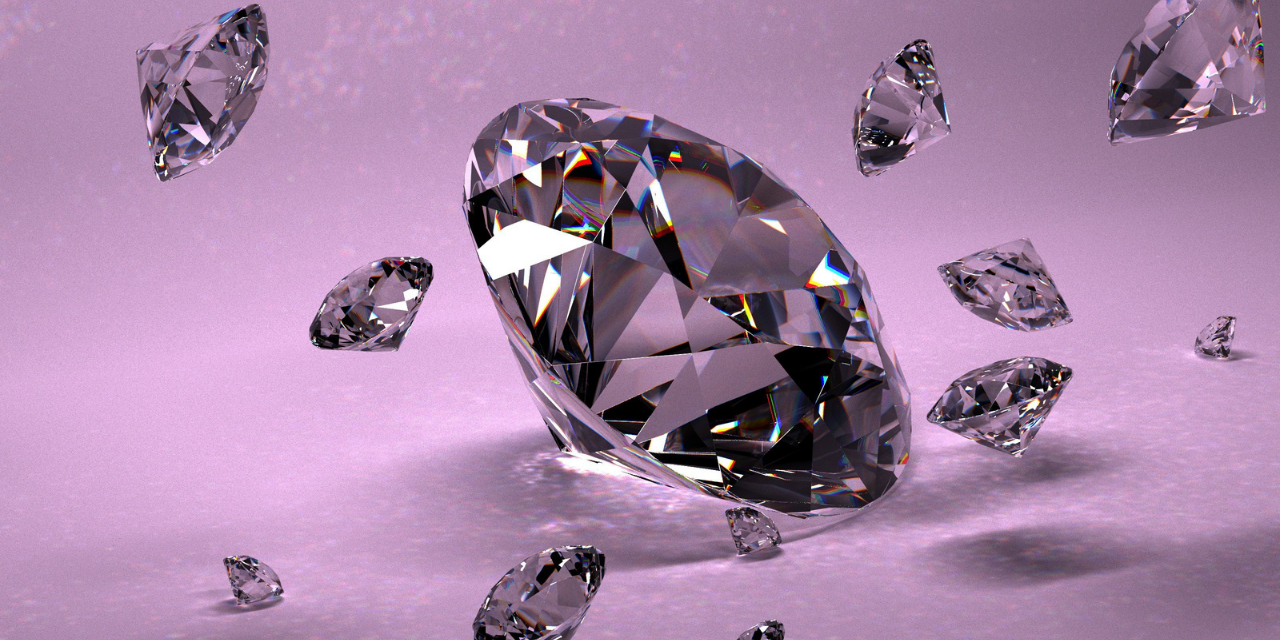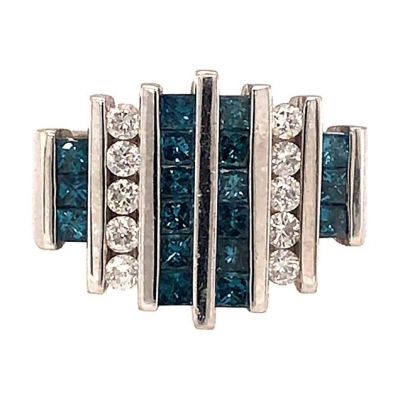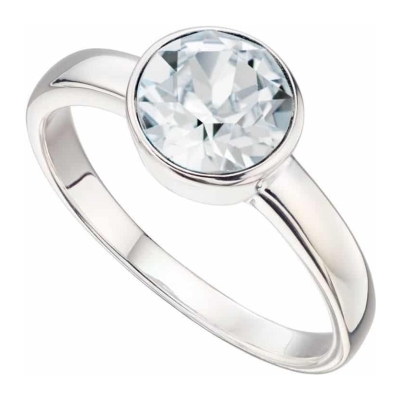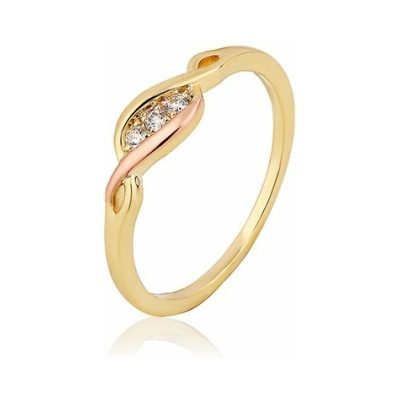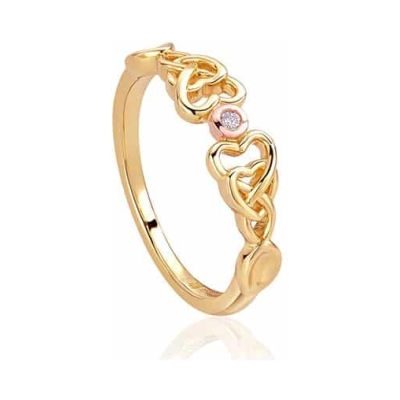If there’s one gemstone that everybody has heard of, it’s Diamond. Not only is it one of the most popular gemstones in the world, but it’s also the April birthstone. So, what actually is a Diamond? How does it form? Where does it come from? What makes it unique? Read on to learn the answers.
What Is Diamond?
Unlike other gemstones and crystals, Diamond has only one element in its formula — C, which represents carbon. Essentially, a Diamond is nothing but a solid form of carbon with its atoms ordered and arranged in a diamond cubic (a form of crystal structure).
It’s believed that Diamonds were found for the first time in the 4th century BC. But diamonds have certainly been around far longer than this, as we now know that they began forming 900 million years ago.
Diamond is a unique gemstone thanks to its hardness, formation process and its general properties.
Over the years, it has become a standard of beauty and endurance in many industries, and it shows no signs of decreasing in value or popularity.
Diamond’s Origins, Properties And Formation Process
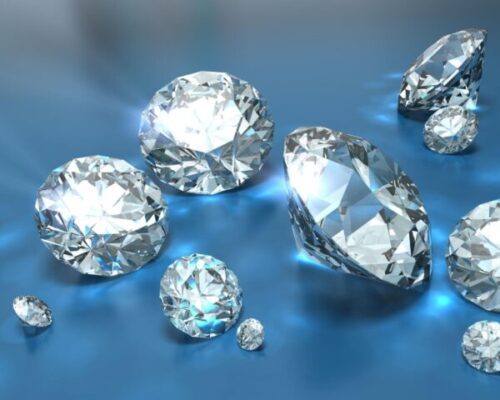
In 1875, one of the best-known diamond mines to this day was opened — Kimberly Mine. It was the first mine outside India with a large deposit of Diamonds that could (at the time) fulfil demand for this precious gemstone.
Today, thanks to its unique properties, diamond is used across multiple industries, and it most certainly holds the status of the top-quality standard.
The fact that it took millions of years for Earth to produce a gemstone with incredible hardness (pure 10 on the Mohs scale) and brilliance like no other, is enough to understand its high price.
You’ve probably heard the saying “It takes pressure to create a Diamond” and it’s certainly true. Around 100 miles beneath the Earth’s surface, carbon deposits undergo immense pressure and high temperatures, and over time, they change their form from amorphous to solid. Without that pressure and high temperature, amorphous carbon would eventually only become graphite, so the specific conditions in the formation process play a key role.
Besides its hardness, Diamond is known for its low friction coefficient, its high electrical resistance, its broad optical transparency, and its resistance to chemical corrosion. And, of course, its incredible brilliance and breath-taking appearance which makes it a popular choice for jewellery!
Lab Grown or Mined Diamonds
Modern technology enables us to preserve the Earth’s resources while still being able to enjoy the things we love. Electric cars, solar panels, and, of course, lab-grown Diamonds.
After years of excavation Diamond deposits are running out. If Diamonds were used only in jewellery this wouldn’t be much of a problem, but they’re used in other industries too, an alternative solution was needed.
The answer was specially equipped laboratories where we can mimic the exact same process that occurs naturally, miles below Earth’s surface. And the best part about it is that it doesn’t take billions of years!
Lab-grown diamonds can be made in less than a month. After they go through the creation process and shaping treatment, there’s no way to tell the difference between mined and lab-grown diamonds because they are essentially the same thing — a solid form of carbon with a face-centred cubic crystal structure.
Make sure to check out our full article on lab-grown diamonds where we talk more about the differences between lab-grown and mined diamonds, and why lab-grown diamonds still haven’t replaced natural diamonds fully in all industries.
Ethical or Non-Ethical Diamonds?
Thinking about whether the Diamonds you’re buying are ethical or not became an issue some years ago, and as time goes by, its importance is becoming greater.
After many Diamond mines opened, the people working there were treated badly – working for less than a pound per day, often with no safety equipment, no breaks or lunch. Many lost their lives working as miners, and no one was held responsible.
The term “Blood Diamonds” is also connected with the ethics of Diamond mining, as during the wars in Africa during the 1990s, Diamond trading was used to fund illegitimate governments and civil wars.
Ethical Diamonds, on the other hand, are those that are mined in ethical conditions, where all the people hired work in a safe environment with their rights respected and honoured, for example in Canadian and Australian mines.
The Birthstone For April – Diamond Usage and Meanings
It’s interesting to note that only 10-15% of Diamonds that exist today are used to make jewellery. Diamond engagement rings are incredibly popular and there’s no sign their popularity will decrease over time. However, they represent just a small percentage of real-world diamond use. Besides jewellery, Diamonds are mostly used in wear parts, cutting tools, thermal management devices, optical components and other high-performance applications.
When it comes to its meaning, just like with any other gemstone, it’s believed that Diamonds have certain metaphysical properties and sometimes even alternative medicine applications. Thousands of years ago, it was believed that Diamonds served as a talisman to banish evil forces, and since their hardness was known, it was believed they provided protection in battles. Wounded soldiers were sometimes given diamonds to ingest, believing they would heal their wounds.
Today, Diamonds are believed to be energy amplifiers, boosting both the positive and negative energies of the wearer. In alternative medicine, they’re believed to help purify and detox all of the body’s systems, and to treat allergies, sight issues and glaucoma.
But whether you believe in alternative medicine and spirituality or not, Diamonds will almost certainly shine beautifully in your silver jewellery collection!
How Much is Diamond Worth?
Since diamonds are much more popular than all other gemstones, their price can vary a lot. The usual metrics that are used to determine the quality (and the price) of diamonds are the 4Cs — colour, clarity, cut and carat.
GIA reports are used as the most trustworthy source of information in determining 4C. In today’s market, one carat of diamond can vary anywhere from £1,900 to £14,000.
In April of 2017, at Sotheby’s Auction in Hong Kong, the most expensive diamond in history was sold — The Pink Star diamond, which has 59.6 carats and went to one lucky buyer for an incredible 71 million US dollars. It was mined in 1999 in South Africa.
Diamond prices are on the rise and are on track to beat the all-time record price they held back in 2012.
Choose Diamond April Birthstone Jewellery
Diamond is the April birthstone, and one of the most popular gemstones in the world, being a prestigious symbol of eternal love. Check out the beautiful diamond pieces of jewellery we have in our shop — earrings, rings and pendants are just some of the pieces we’re confident you will love! Or discover our extensive range of other birthstone jewellery to find the ideal gift for someone special.
